Douglas DC-7
| DC-7 | |
|---|---|
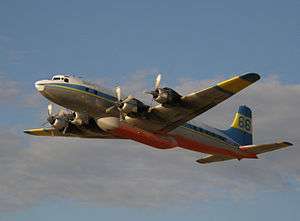 | |
| Butler Aircraft Services' DC-7, Tanker 66 | |
| Role | Airliner and transport aircraft |
| National origin | United States |
| Manufacturer | Douglas Aircraft Company |
| First flight | 18 May 1953 |
| Introduction | 29 November 1953 |
| Primary users | American Airlines (historical) United Airlines (historical) Eastern Air Lines (historical) Pan Am (historical) |
| Produced | 1953–1958 |
| Number built | 338[1] |
| Developed from | Douglas DC-6 |
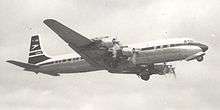
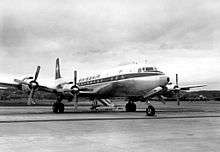

The Douglas DC-7 is a transport aircraft built by the Douglas Aircraft Company from 1953 to 1958. It was the last major piston engine-powered transport made by Douglas, being developed shortly after the earliest jet airliner—the de Havilland Comet—entered service and only a few years before the jet-powered Douglas DC-8 first flew.
Design and development
In 1945 Pan American World Airways requested a DC-7, a civil version of the Douglas C-74 Globemaster military transport. Pan Am soon canceled their order. That proposed DC-7 was unrelated to the later airliner.
American Airlines revived the designation when they requested an aircraft that could fly the USA coast-to-coast non-stop in about eight hours. (Civil Air Regulations then limited domestic flight crews to 8 hours' flight time in any 24-hour period.[2][3]) Douglas was reluctant to build the aircraft until American Airlines president C. R. Smith ordered 25 at a price of $40 million, thus covering Douglas' development costs.
The DC-7 wing was based on the DC-4's, with the same span; the fuselage was 40 inches longer than the DC-6B. Four eighteen-cylinder Wright R-3350 Duplex-Cyclone Turbo-Compound engines provided power.[4] The prototype flew in May 1953 and American received their first DC-7 in November, inaugurating the first non-stop east-coast-to-west-coast service in the country (unrealistically scheduled just under the eight-hour limit for one crew) and forcing rival TWA to offer a similar service with its Super Constellations. Both aircraft frequently experienced inflight engine failures, causing many flights to be diverted. Some blamed this on the need for high-power settings to meet the notional schedules, causing overheating and failure of the engines' power recovery turbines.[5]
The DC-7 was followed by the DC-7B with slightly more power, and on some DC-7Bs (Pan Am and South African Airways), fuel tanks over the wing in the rear of the engine nacelles, each carrying 220 US gallons (183 imp gal; 833 l). South African Airways used this variant to fly Johannesburg to London with one stop. Pan Am's DC-7Bs started flying transatlantic in summer 1955, scheduled 1 hr 45 min faster than the Super Stratocruiser from New York to London or Paris.
Operational history
Early DC-7s were purchased only by U.S. carriers. European carriers could not take advantage of the small range-increase of the early DC-7, so Douglas released an extended-range variant, the DC-7C (Seven Seas) in 1956. Two 5 ft (1.5 m) wingroot inserts added fuel capacity, reduced interference drag and made the cabin quieter by moving the engines farther outboard; all DC-7Cs had the nacelle fuel tanks previously seen on Pan American's and South African's DC-7Bs. The fuselage, which had been extended over the DC-6B's with a 40-inch (100 cm) plug behind the wing for the DC-7 and DC-7B, was lengthened with a 40-inch plug ahead of the wing to give the DC-7C a total length of 112 ft 3 in (34.21 m).
Since the late 1940s Pan Am and other airlines had scheduled a few non-stop flights from New York to Europe, but westward non-stops against the prevailing wind were rarely possible with an economic payload. The L1049G and DC-7B that appeared in 1955 could occasionally make the westward trip, but in summer 1956 Pan Am's DC-7C finally started doing it fairly reliably. BOAC was forced to respond by purchasing DC-7Cs rather than wait on the delivery of the Bristol Britannia. The DC-7C found its way into several other overseas airlines' fleets, including SAS, which used them on cross-polar flights to North America and Asia. The DC-7C sold better than its rival, the Lockheed L-1649A Starliner, which entered service a year later,[6] but sales were cut short by the arrival of Boeing 707 and Douglas DC-8 jets in 1958–60.
Starting in 1959 Douglas began converting DC-7s and DC-7Cs into DC-7F freighters to extend their useful lives. The airframes were fitted with large forward and rear freight doors and some cabin windows were removed.
The predecessor DC-6, especially the DC-6B, established a reputation for straightforward engineering and reliability. Pratt & Whitney, manufacturer of the DC-6's Double Wasp engines, did not offer an effective larger engine apart from the Wasp Major, which had a reputation for poor reliability. Douglas turned to Wright Aeronautical for a more powerful engine. The Duplex-Cyclone had reliability issues of its own, and this affected the DC-7's service record. Carriers who had both DC-6s and DC-7s in their fleets usually replaced the newer DC-7s first once jets started to arrive. Some airlines retired their DC-7s after little more than five years of service, whereas most DC-6s lasted longer and sold more readily on the secondhand market.
Basic price of a new DC-7 was around £570,000 ($823,308).[7]
Price of a DC-7B was around £680,000 ($982,226) in 1955, rising to £820,000 ($1,184,490) in 1957.[7]
Similarly, the price of a DC-7C was £800,000 ($1,155,560) in 1956, increasing to £930,000 ($1,343,385) by 1958.[8]
Cost of the DC-7F "Speedfreighter" conversion was around £115,000 ($166,112) per aircraft.[8]
Variants
- DC-7
- Production variant, 105 built.
- DC-7B
- First long-range variant with higher gross weight and fuel capacity, with most of the added fuel in saddle tanks in enlarged engine nacelles. (Only Pan Am and South African DC-7Bs had the saddle tanks.) 112 built.
- DC-7C Seven Seas
- Longer-range variant with non-stop transatlantic capability, improved 3400hp (2540kW) R-3350 engines and increased fuel capacity mainly in longer wings, 121 built.
- DC-7D
- Unbuilt variant with Rolls-Royce Tyne turboprops.
- DC-7F
- Freight conversion of all three variants with two large freight doors.
Operators
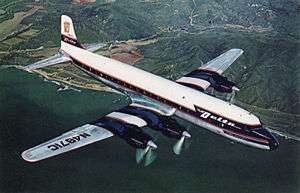
Airlines
DC-7s were used by Alitalia, American Airlines, BOAC, Braniff Airways, Caledonian Airways, Delta Air Lines, Eastern Air Lines, Japan Airlines, KLM, Mexicana de Aviacion, National Airlines, Northwest Orient, Panair do Brasil, Pan American World Airways, Sabena, SAS, South African Airways, Swissair, Turkish Airlines, Transports Aériens Intercontinentaux, and United Airlines.
Seventeen DC-7s remained on the U.S. registry in 2010,[9] used mainly for cargo and as aerial firefighting airtankers. Due to its engine problems, the DC-7 has not had the same longevity as the DC-6, which is still used by a number of commercial operators.
Military operators
Orders and production
| Airline | DC-7 | DC-7B | DC-7C | Notes |
|---|---|---|---|---|
| Alitalia | — | — | 6 | |
| American Airlines | 34 | 24 | — | Launch customer for the DC-7 with an original order for 25 |
| British Overseas Airways Corporation | — | — | 10 | |
| Braniff Airways | — | — | 7 | |
| Continental Air Lines | — | 5 | — | |
| Delta Air Lines | 10 | 10 | — | |
| Eastern Air Lines | — | 49 | — | |
| Iran Air | — | — | 1 | |
| Japan Air Lines | — | — | 4 | |
| KLM | — | — | 15 | |
| Mexicana | — | — | 4 | |
| National Airlines | 4 | 4 | — | |
| Northwest Orient Airlines | — | — | 14 | |
| Panagra | — | 6 | — | |
| Pan American World Airways | — | 6 | 27 | |
| Panair do Brasil | — | — | 2 | |
| Persian Air Services | — | — | 2 | |
| Sabena | — | — | 10 | 3 were leased |
| Scandinavian Airlines System | — | — | 14 | |
| South African Airways | — | 4 | — | |
| Swissair | — | — | 5 | |
| Transports Aériens Intercontinentaux | — | — | 4 | |
| United Airlines | 57 | — | — | 2 were lost in mid-air collisions |
| Douglas Aircraft | — | 2 | — | Written off before delivery |
| — | 1 | — | DC-7B prototype delivered to Delta Air Lines | |
| — | — | 1 | DC-7C prototype delivered to Panair do Brasil | |
| Total | 105 | 112 | 121 | Total built: 338 |
Accidents and incidents
The Douglas DC-7 suffered 79 incidents and accidents with a total of 714 fatalities.[10]
- June 30, 1956
- United Airlines Flight 718, a DC-7, collided over the Grand Canyon with TWA Flight 2, an L-1049 Super Constellation, resulting in the deaths of 128 people on both aircraft.
- January 31, 1957
- A DC-7 (N8210H) still owned by Douglas crashed into a school yard in the Pacoima area of Los Angeles, California, following a midair collision with Northrop F-89J Scorpion 52-1870, resulting in the deaths of the four crewmembers aboard the DC-7, the pilot of the Scorpion jet, and three students on the ground.[11][12]
- June 28, 1957
- An Eastern Air Lines DC-7B (N808D) collided with a parked Eastern Air Lines Lockheed L-1049 (N6212C) at Miami International Airport after returning from a training flight. Fuel leaked and both aircraft burned out.[13]
- February 1, 1958
- Pan Am Flight 70, a DC-7C (N733PA, Clipper Blue Jacket), landed wheels-up at Schiphol Airport as a result of pilot error; all 16 on board survived, but the aircraft was written off.[14]
- March 10, 1958
- A DC-7B (N846D) still owned by Douglas crashed at Long Beach, California during a test flight before delivery to Eastern Air Lines.[15]
- March 25, 1958
- Braniff Flight 971, a DC-7C (N5904), crashed shortly after takeoff from Miami while attempting to return after an engine caught fire. Nine passengers out of 24 people aboard died in the accident.[16]
- April 21, 1958
- United Airlines Flight 736, a DC-7 en route from Los Angeles to Denver, collided with USAF North American F-100 Super Sabre 56-3755 near Las Vegas. Both aircraft crashed out of control resulting in the deaths of 49 people.
- May 18, 1958
- A Sabena DC-7C (OO-SFA) crashed near Casablanca Airport during an emergency landing. All nine crewmembers and 52 of the 56 passengers died.[17]
- September 24, 1959
- TAI Flight 307, a DC-7C, crashed at Bordeaux airport with the loss of 54 lives. After takeoff, the aircraft failed to gain altitude and collided with trees 3 km (1.9 mi) from the start of the takeoff.
- November 16, 1959
- National Airlines Flight 967, a DC-7B on a flight from Tampa, Florida, to New Orleans, crashed into the Gulf of Mexico. All 42 occupants perished. Although sabotage was suspected, no definite cause of the crash was determined due to a lack of evidence. The aircraft was owned by Delta Air Lines.[18]
- February 26, 1960
- Alitalia Flight 618, a DC-7C (I-DUVO), crashed at Shannon Airport, Ireland, shortly after takeoff following a loss of altitude while making a left turn with 34 fatalities out of 52 passengers and crew. No cause was established for this accident.[19]
- July 14, 1960
- Northwest Orient Airlines Flight 1-11, a DC-7C (N292), ditched off Polillo Island, Philippines due to failure of the number two engine and fire; one person (out of 58 on board) died when the number two propeller separated and penetrated the fuselage.[20]
- November 1, 1961
- A Panair do Brasil DC-7C (PP-PDO) flying from Sal to Recife crashed into a hill about 2.7 km (1.7 mi) short of the runway at Recife. Forty-five passengers and crew out of the 88 persons aboard lost their lives. The accident was attributed to pilot error.[21][22]
- March 6, 1962
- Caledonian Airways Flight 153 crashed into a swamp shortly after takeoff from Douala International Airport; all 111 people on board died. It is the worst single-aircraft accident of a DC-7.
- October 22, 1962
- Northwest Airlines Flight 292, a DC-7C (N285) with 7 crew and 95 passengers,[23] made a successful water landing in Sitka Sound just before 1 p.m. local time after struggling with propeller problems for 45 minutes[24] while operating as a military charter flight between McChord Air Force Base and Elmendorf Air Force Base. The plane stayed afloat for 24 minutes after coming to rest in the water, giving the occupants ample time to evacuate into life rafts with only 6 minor injuries reported. All passengers and crew were quickly rescued by U.S. Coast Guard ships.[25]The cause was an overspeeding propeller when the blower section on engine number two failed.
- November 30, 1962
- Eastern Air Lines Flight 512, a DC-7B on a flight from Charlotte, North Carolina, to New York-Idlewild, crashed after a missed approach due to fog. This accident, which cost 25 lives (out of 51 onboard), was attributed to improper crew procedures.
- June 3, 1963
- Northwest Airlines Flight 293, a Military Air Transport Service flight from McChord Air Force Base in Washington state to Elmendorf Air Force Base in Alaska crashed into the Pacific Ocean near Annette Island, Alaska, with the loss of all 101 people aboard. Due to the lack of evidence, no cause was established for this accident.
- February 8, 1965
- Eastern Air Lines Flight 663 crashed a few minutes after takeoff from John F. Kennedy Airport in New York after taking evasive action to avoid a possible collision with another airliner (Pan Am Flight 212, a Boeing 707). All 84 passengers and crew died.
- December 7, 1968
- A North American Aircraft Trading DC-7C (VR-BCY) crashed during approach to Uli Airstrip following triple engine failure during a relief flight, killing all four crew.[26]
- June 5, 1969
- A Swedish Red Cross DC-7B (SE-ERP) was shot down by a Nigerian Air Force MiG-17 and crashed at Eket, Nigeria, killing all four crew. The aircraft was operating a supply flight from Fernando Po (now Bioko) to Biafra.[27]
- October 2, 1970
- A Spantax DC-7C (EC-ATQ) was written off at Barajas Airport.[28]
- December 31, 1972
- Professional Baseball player Roberto Clemente and 4 others in a chartered DC-7 died when the plane crashed shortly after takeoff from San Juan, Puerto Rico. Only parts of the fuselage and the body of pilot Jerry Hill were recovered. The cause was traced to maintenance and pilot errors.[29]
- June 21, 1973
- A Skyways International DC-7C (N296) crashed in the Everglades six minutes after takeoff from Miami International Airport, apparently caused by an onboard fire and/or severe turbulence. Three crew members, the sole occupants, died. The aircraft was on lease to Warnaco Incorporated.[30]
- March 3, 1974
- A Douglas DC-7C/F (EI-AWG) operating an Aer Turas Teo charter flight from Dublin landed at Luton Airport on runway 08 just after midnight but failed to achieve reverse thrust. Normal braking application also was ineffective and the emergency pneumatic brakes were applied. All main wheel tires burst. The aircraft overran the runway and continued over the steep bank at the eastern perimeter finally coming to rest in soft ground 90 metres beyond. The situation had also been made worse by an inadvertent application of forward thrust by the crew in trying to achieve reverse thrust. Three of the six passengers and two of the four crew were injured. The aircraft was badly damaged and deemed a write-off.[31]
- October 4, 1976
- An Emirates Air Transport DC-7CF (TZ-ARC) struck Mount Kenya due to a premature descent, killing the four crew.[32]
- September 12, 1977
- A Safe Air Cargo DC-7BF (N6314J) crashed on climbout from Yakutat Airport after an engine lost power and caught fire, killing the four crew. 14 CFR 91 subpart D was revised in the wake of this accident.[33]
- September 6, 1978
- An Advance Aviation Inc. DC-7CF (N244B) was being used to smuggle marijuana when it crashed near Farmerville, Louisiana due to pilot error, killing one of six on board. Thirty-five bales of marijuana were recovered from the wreckage.[34]
- June 22, 1979
- A Go Transportation DC-7CF (N357AL) crashed on climbout from Barstow Airport due to overloading and loss of engine power (caused by improper 100 octane fuel), killing one of six crew.[35]
- September 14, 1979
- A Butler Aircraft Inc. DC-7 (N4SW) transporting company employees to Medford, Oregon crashed on the crest of Surveyor Mountain near Klamath Falls, Oregon. The crash, which claimed the 12 occupants aboard, was attributed to the crew's decision to undertake a night flight at low altitude.
- 1980
- An Aero Services Corp. DC-7CF (N8219H) was shot down and crashed in Colombia during a smuggling flight.[36]
- July 27, 1980
- A Lambda Air Cargo DC-7CF (CP-1291) burned out on the ground at Trujillo Airport.[37]
- November 28, 1980
- A Central Air Service DC-7B (N816D) crashed near Pecos City Airport, Texas after the aircraft went into a fast descent after it entered a 90° bank after takeoff, killing both pilots.[38]
- October 9, 1986
- A T&G Aviation DC-7C (N5903) ditched off Dakar due to engine problems, killing three of four crew.[39]
- December 8, 1988
- A T&G Aviation DC-7CF (N284) was shot down by a SAM-7 missile fired by the Polisario Front and crashed in the Western Sahara, killing the five crew. A second T&G DC-7 (N90984) was also hit, losing an engine, but was able to land safely. Polisario soldiers thought the aircraft were Moroccan C-130s.[40][41]
- October 1, 1992
- A TBM Incorporated DC-7B (N848D) crashed near Union Valley Reservoir due to pilot error and poor crew resource management, killing both pilots.[42]
Surviving aircraft
A flight school owner at the New Smyrna Beach Airport has restored a DC-7 to serve as a restaurant, the DC-7 Grille,[43] but it never opened.
A DC-7 tail number C-0921 (nicknamed "Charlie 21") was installed at Iliff Preschool in Denver in 1971 and is still serving as a kindergarten classroom.[44] [45]
Specifications

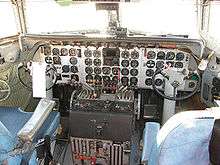
DC-7
Data from American Museum of Aviation[46]
General characteristics
- Crew: 2 Pilots, 1 Flight Engineer, 2 Flight Attendants
- Capacity: 64 to 95 Passengers
- Length: 108 ft, 11 in (33.20 m)
- Wingspan: 117 ft, 6 in (35.81 m)
- Height: 28 ft, 7 in (8.71 m)
- Empty weight: 58,150 lbs (26,376 kg)
- Max. takeoff weight: 114,600 to 122,000 lbs (51,982 to 55,338 kg)
- Powerplant: 4 × Wright R-3350-30W Duplex Cyclone radial piston engines, 3,250 hp (2,423 kW) each
Performance
- Maximum speed: 405 mph (652 km/h)
- Cruise speed: 359 mph (578 km/h)
- Stall speed: 97 mph (156 km/h)
- Range: 5,164 mi w/ max fuel & 3,565 mi w/ max payload (8,311 km w/ max fuel & 5,737 km w/ max payload)
- Service ceiling: 28,400 ft (8,656 m)
DC-7C
Data from American Museum of Aviation[46]
General characteristics
- Crew: 2 Pilots, 1 Flight Engineer, 4 Flight attendants
- Capacity: 105 Passengers
- Length: 112 ft, 3 in (34.21 m)
- Wingspan: 127 ft, 6 in (38.86 m)
- Height: 31 ft, 10 in (9.70 m)
- Empty weight: 72,763 lbs (33,005 kg)
- Max. takeoff weight: 143,000 lbs (64,864 kg)
- Powerplant: 4 × Wright R-3350-988TC18EA1-2 radial piston engines, 3400 hp (2,536 kW) each
Performance
- Maximum speed: 406 mph (653 km/h)
- Cruise speed: 359 mph (578 km/h)
- Stall speed: 97 mph (156 km/h)
- Range: 5,600 mi (9,012 km)
- Service ceiling: 28,400 ft (8,656 m)
See also
Related development
Aircraft of comparable role, configuration and era
- Boeing 377 Stratocruiser
- Bristol Britannia
- Lockheed Constellation
- Lockheed L-049 Constellation
- Lockheed L-1049 Super Constellation
- Lockheed L-1649 Starliner
Related lists
References
Notes
- ↑ "Boeing: Historical Snapshot: DC-7 Transport". www.boeing.com. Retrieved 2 April 2018.
- ↑ Aviation Week, February 1, 1954, p. 16.
- ↑ Aviation Week, June 21, 1954 p. 16.
- ↑ "Douglas Airlines". Sport Aviation, April 2012, p. 19.
- ↑ Aviation Week, April 21, 1958, p. 38:
- ↑ Breffort, Dominique. Lockheed Constellation: From Excalibur to Starliner, Civilian and Military Variants. Paris: Histoire and Collecions, 2006. ISBN 2-915239-62-2
- 1 2 "Max take-off, Hamilton Standard, price today." Flight Archive, 1960.
- 1 2 "Douglas." Flight Archive, 1960.
- ↑ "FAA registration database." Archived 2007-11-13 at the Wayback Machine. FAA. Retrieved: November 26, 2010.
- ↑ "Douglas DC-7 accidents and incidents". Aviation Safety Network. Retrieved September 21, 2017.
- ↑ Hill, Gladwyn (February 1, 1957). "7 Die as Planes Collide and One Falls in Schoolyard; PLANES COLLIDE, SCHOOL YARD HIT; Roar Alerts Students 'Everything on Fire' Witness Describes Crash". The New York Times. p. 1. Retrieved February 3, 2010.
- ↑ Accident description for N8210H at the Aviation Safety Network. Retrieved on February 3, 2010.
- ↑ Hull-loss description for N808D at the Aviation Safety Network. Retrieved on September 21, 2017.
- ↑ Accident description for N733PA at the Aviation Safety Network. Retrieved on September 21, 2017.
- ↑ Accident description for N846D at the Aviation Safety Network. Retrieved on September 21, 2017.
- ↑ "Douglas DC-7C N5904". Aviation Safety Network. Retrieved: September 6, 2013.
- ↑ "Douglas DC-7C OO-SFA." Aviation Safety Network. Retrieved: September 6, 2013.
- ↑ "Aircraft Accident Report" (PDF). specialcollection.net. December 22, 2011. Archived from the original (PDF) on May 3, 2014.
- ↑ Accident description for I-DUVO at the Aviation Safety Network. Retrieved on September 6, 2013.
- ↑ Accident description for N292 at the Aviation Safety Network. Retrieved on September 6, 2013.
- ↑ "Accident description PP-PDO." Aviation Safety Network. Retrieved: May 20, 2011.
- ↑ Germano da Silva 2008, pp. 197–203.
- ↑ Aircraft Accident Report: Douglas DC-7C, N285 Northwest Airlines, Inc. Ditching in Sitka Sound, Alaska October 22, 1962. Washington, D.C.: Civil Aeronautics Board. 19 September 1963. p. 1.
- ↑ "DC-7 Ditches In Sea Near Sitka; All Safe". The Seattle Daily Times. 22 October 1962.
- ↑ Sims, Ward T. (23 October 1962). "102 Saved As Plane Ditches". Seattle Post Intelligencer.
- ↑ Accident description for VR-BCY at the Aviation Safety Network. Retrieved on September 21, 2017.
- ↑ Criminal description for SE-ERP at the Aviation Safety Network. Retrieved on September 21, 2017.
- ↑ Hull-loss description for EC-ATQ at the Aviation Safety Network. Retrieved on September 21, 2017.
- ↑ "Roberto Clemente While Flying A Relief Mission To Earthquake Torn Nicaragua Dies In Plane Crash." avstop.com. Retrieved: November 26, 2010.
- ↑ Accident description for N296 at the Aviation Safety Network. Retrieved on 29 November 2013.
- ↑ "Accident description: Douglas DC-7CF EI-AWG". Aviation Safety Network, 2013. Retrieved: October 10, 2013.
- ↑ Accident description for TZ-ARC at the Aviation Safety Network. Retrieved on 29 November 2013.
- ↑ Accident description for N6314J at the Aviation Safety Network. Retrieved on 29 November 2013.
- ↑ Accident description for N244B at the Aviation Safety Network. Retrieved on 29 November 2013.
- ↑ Accident description for N357AL at the Aviation Safety Network. Retrieved on September 21, 2017.
- ↑ Criminal description for N8219H at the Aviation Safety Network. Retrieved on September 22, 2017.
- ↑ Hull-loss description for CP-1291 at the Aviation Safety Network. Retrieved on September 22, 2017.
- ↑ Accident description for N816D at the Aviation Safety Network. Retrieved on September 21, 2017.
- ↑ Accident description for N5903 at the Aviation Safety Network. Retrieved on September 21, 2017.
- ↑ Criminal description for N284 at the Aviation Safety Network. Retrieved on November 29, 2013.
- ↑ Criminal description for N90984 at the Aviation Safety Network. Retrieved on September 21, 2017.
- ↑ Accident description for N848D at the Aviation Safety Network. Retrieved on 29 November 2013.
- ↑ "DC-7 plane to be converted into restaurant". Retrieved April 12, 2013.
- ↑ "Iliff Pre School, Denver, CO, USA - DC-7". Retrieved 13 July 2018.
- ↑ "Charlie 21". Retrieved 13 July 2018.
- 1 2 "Douglas DC-7." American Museum of Aviation. Retrieved: December 22, 2011.
Bibliography
- Germano da Silva, Carlos Ari César. "Buraco negro." O rastro da bruxa: história da aviação comercial brasileira no século XX através dos seus acidentes 1928–1996 (in Portuguese). Porto Alegre: Edipucrs, Second edition, 2008. ISBN 978-85-7430-760-2.
- Pearcy, Arthur. Douglas Propliners: DC-1–DC-7. Shrewsbury, UK: Airlife Publishing, 1995. ISBN 1-85310-261-X.
- United States Air Force Museum Guidebook. Wright-Patterson AFB, Ohio; Air Force Museum Foundation, 1975.
- Whittle, John A. The Douglas DC-6 and DC-7 Series. Tonbridge, Kent, UK: Air Britain (Historians) Ltd., 1971. No ISBN.
- Wilson, Stewart. Airliners of the World. Fyshwick, ACT, Australia: Aerospace Publications Pty Ltd, 1999. ISBN 1-875671-44-7
- Yenne, Bill. McDonnell Douglas: A Tale of Two Giants. Greenwich, Connecticut: Bison Books, 1985. ISBN 0-517-44287-6.
External links
| Wikimedia Commons has media related to Douglas DC-7. |
- Boeing McDonnell Douglas page on DC-7
- Airliners.net on the DC-7
- Smithsonian National Air and Space Museum page on the DC-7 – features panorama views of cockpit and forward cabin
Douglas and McDonnell Douglas aircraft production timeline, 1950-2006 | ||||||||||||||||||||||||||||||||||||||||||||||||||||||||||||
|---|---|---|---|---|---|---|---|---|---|---|---|---|---|---|---|---|---|---|---|---|---|---|---|---|---|---|---|---|---|---|---|---|---|---|---|---|---|---|---|---|---|---|---|---|---|---|---|---|---|---|---|---|---|---|---|---|---|---|---|---|
| 1950s | 1960s | 1970s | 1980s | 1990s | 2000s | |||||||||||||||||||||||||||||||||||||||||||||||||||||||
| 0 | 1 | 2 | 3 | 4 | 5 | 6 | 7 | 8 | 9 | 0 | 1 | 2 | 3 | 4 | 5 | 6 | 7 | 8 | 9 | 0 | 1 | 2 | 3 | 4 | 5 | 6 | 7 | 8 | 9 | 0 | 1 | 2 | 3 | 4 | 5 | 6 | 7 | 8 | 9 | 0 | 1 | 2 | 3 | 4 | 5 | 6 | 7 | 8 | 9 | 0 | 1 | 2 | 3 | 4 | 5 | 6 | 7 | 8 | 9 | |
| Douglas DC-6 | ||||||||||||||||||||||||||||||||||||||||||||||||||||||||||||
| DC-7 | ||||||||||||||||||||||||||||||||||||||||||||||||||||||||||||
| Douglas DC-8 | ||||||||||||||||||||||||||||||||||||||||||||||||||||||||||||
| McDonnell Douglas DC-9 | ||||||||||||||||||||||||||||||||||||||||||||||||||||||||||||
| McDonnell Douglas MD-80 | ||||||||||||||||||||||||||||||||||||||||||||||||||||||||||||
| MDD MD-90 | ||||||||||||||||||||||||||||||||||||||||||||||||||||||||||||
| MD-95 / B717 | ||||||||||||||||||||||||||||||||||||||||||||||||||||||||||||
| McDonnell Douglas DC-10 | MD-11 | |||||||||||||||||||||||||||||||||||||||||||||||||||||||||||
| = Piston-engined | = Narrow-body jet | = Wide-body jet | ||||||||||||||||||||||||||||||||||||||||||||||||||||||||||